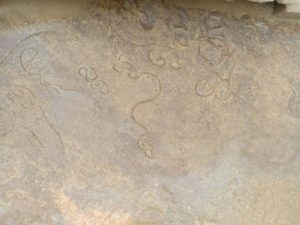Published on: September 18, 2021
SHANKHALIPI SCRIPT
SHANKHALIPI SCRIPT
What:
- Shankhalipi or “shell-script” is a term used by scholars to describe ornate spiral characters assumed to be Brahmi derivatives that look like conch shells or shankhas.
- They are found in inscriptions across north-central India and date to between the 4th and 8th centuries.
- A similar inscription was found on the back of a stone horse sculpture from that period that is at present in the State Museum at Lucknow.
- Both Shankhalipi and Brahmi are stylised scripts used primarily for names and signatures.
- The inscriptions consist of a small number of characters, suggesting that the shell inscriptions are names or auspicious symbols or a combination of the two.
- The script was discovered in 1836 on a brass trident in Uttarakhand’s Barahat by English scholar James Prinsep, who was the founding editor of the Journal of the Asiatic Society of Bengal.
- A year later, he came across two more similar scripts at Nagarjuna group of caves in the Barabar Hills near Gaya.
- Prominent sites with shell inscriptions include the Mundeshwari Temple in Bihar, the Udayagiri Caves in Madhya Pradesh, Mansar in Maharashtra and some of the cave sites of Gujarat and Maharashtra. In fact, shell inscriptions are also reported in Indonesia’s Java and Borneo.
- The first detailed study of shell inscriptions was undertaken by Professor Richard Salomon of the University of Washington.
- Shankhalipi is found to be engraved on temple pillars, columns and rock surfaces.

What is in news : Archaeological Survey of India (ASI) discovered remains of an ancient temple dating back to the Gupta period (5th century) in a village in Uttar Pradesh’s Etah district recently
Details :
- The stairs of the temple had ‘shankhalipi’ inscriptions, which were deciphered by the archaeologists as saying, ‘Sri Mahendraditya’, the title of Kumaragupta I of the Gupta dynasty.
- The Bilsarh sites was declared ‘protected’ in 1928. Every year, the ASI undertakes scrubbing work at the protected sites.
- As per the ASI, the stairs led to a structural temple built during the Gupta period. The discovery becomes significant since only two other structural temples from the Gupta age have been found so far — Dashavatara Temple (Deogarh) and Bhitargaon Temple (Kanpur Dehat).

